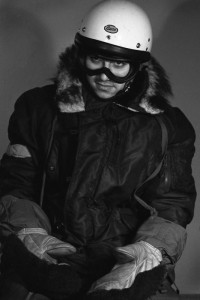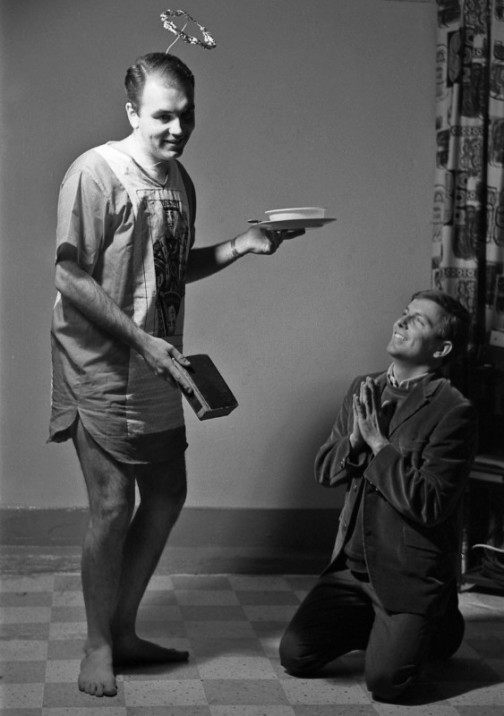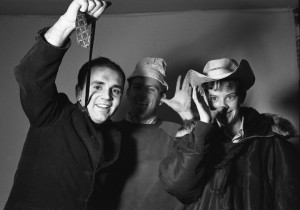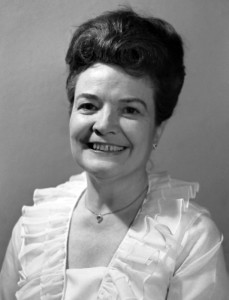Sir–Did you by any chance have a dark room in the basement of my parents’ house on University Ave in SLC? Back in the 60’s, I guess. – Mike Harris
The Internet is amazing. Out of the clear blue sky comes a message from a person—now nearing retirement age—who, when I last saw him, was just a freckle-faced lad. And yes, I am indeed the photographer who lived in his basement and had a darkroom in the fruit cellar. It was the autumn of 1966; I was 23 years old and had just hit rock bottom.
All that summer I had toiled as a door-to-door salesman, hoping to save up enough money to attend college in Mexico City. Why Mexico? Well, it sounded exotic, and I’d been accepted into the postgraduate writing program at the University of the Americas. My goals: To write a novel, learn Spanish, learn to play a guitar, and—perhaps most important—avoid the draft.
Alas, come fall I had banked only about four hundred dollars. “That’s not enough,” said my father, and that was that. My heart sank. I turned to a girlfriend for comfort. “I don’t think I shall ever have anything in common with a Jewel Tea Man,” she sniffed, and moved on to greener pastures.
Fact is, I myself had nothing in common with the Jewel Tea Company. I hated route sales; I was no good at it, and had been counting the days until I could park my little brown step van and flee to sunny Mexico.
Instead, I found myself jobless and wandering the streets of Salt Lake City, looking for a place to come in from the cold. Presently I found a room in the basement of the Harris house near the University of Utah. I was one of three subterranean tenants, each of whom was to figure prominently in my life. First, there was my roommate Ron Crouch, a premed student from an isolated religious colony in the West Utah Desert. Eskdale had no telephone service, so in order to call home, Ron had rigged an antenna on the roof, which was connected to a short wave radio. On holidays, Ron—dressed like Nanook of the North—would set out for Eskdale astride a Vespa motorscooter. It was Ron who saved me from starvation by setting up an arrangement whereby I could enjoy one home cooked meal per day, served up by his sister commune members, the so-called “Daughters of Levi.” Monthly cost of a meal ticket—just ten bucks!
Another cellar dweller was a very talented artist, William Whitaker. Though still in school, Bill was already employed by Evans Advertising, producing religious paintings for the Mormon Church. Whitaker hired me as a model after noticing I have beautiful hands—hands that today are on prominent display at Temple Square. Look closely at the painting of Joseph Smith kneeling in the Sacred Grove. Those are my hands reaching out to receive the golden plates from the Angel Moroni!
The fourth cellar dweller was a law student named Robert Macri. Like me, Bob had earned his bachelor’s degree at BYU, and—also like me—had come away from that institution disenchanted with the faith. One night, if for no other reason than to annoy Bill Whitaker, Bob dressed up like an angel—complete with a tin foil halo. In this picture he is seen handing me a book and some plates. Not golden plates, just ordinary dinner plates. Shortly thereafter, I was assassinated by an angry mob. A member of that angry mob is none other than young Michael Harris, wearing a cowboy hat and Ron Crouch’s Nanook of the North parka.
That’s the way it was at the Harris household—a lot of interaction between family members upstairs and tenants in the basement. Mike’s older sister was less involved, understandably so—as was her father, who was often out of town on business. Evidently it was the family matriarch, Patti Harris, who had decided to rent out the basement to students, not because she needed the money but because she enjoyed having company. She took an interest in our lives, in particular mine. She was worried because I appeared to be rootless and without future plans. In fact, I wasn’t just falling behind; I was fading away.
That fall I spent a great deal of time sitting underneath a tree in Reservoir Park, poring over Ron Crouch’s medical texts. In particular, I was interested in case studies of depression and suicide, for it seemed to me at the time that hanging myself might be a reasonable thing to do. From her kitchen window, Mrs. Harris would watch, her brow furrowed. Now and again, she’d invite me in for a cup of tea, and, by and by, I began to feel better—thanks in large part to a lovely Irish lady who provided me a cot to sleep in, a chair to sit on, a windowless room suitable for developing film, a warm cup of tea—and sympathy.



